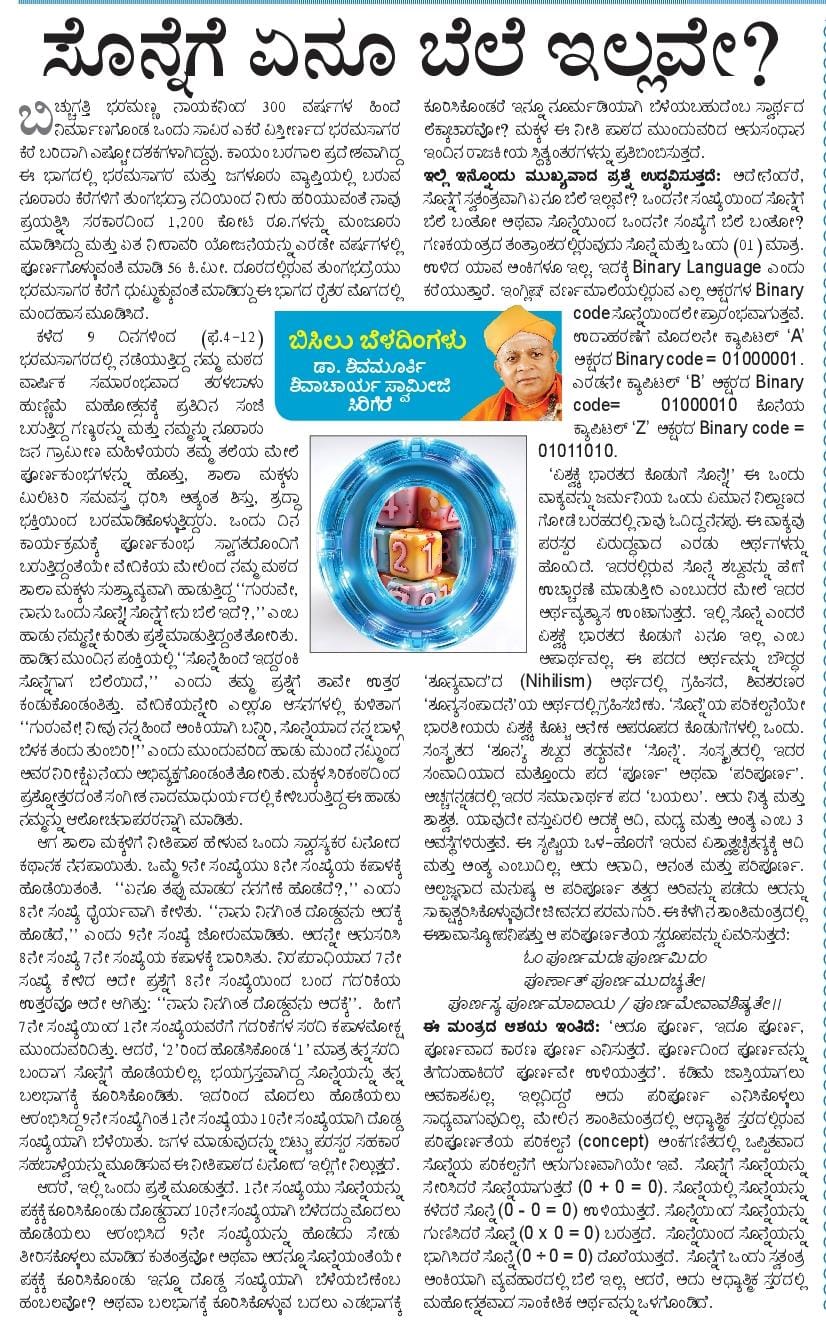
р▓мр▓┐р▓Ър│Нр▓Ър│Бр▓Чр▓др│Нр▓др▓┐ р▓нр▓░р▓ор▓гр│Нр▓г р▓ир▓╛р▓пр▓Хр▓ир▓┐р▓Вр▓ж 300 р▓╡р▓░р│Нр▓╖р▓Чр▓│ р▓╣р▓┐р▓Вр▓жр│Ж р▓ир▓┐р▓░р│Нр▓ор▓╛р▓гр▓Чр│Кр▓Вр▓б р▓Тр▓Вр▓жр│Б р▓╕р▓╛р▓╡р▓┐р▓░ р▓Ор▓Хр▓░р│Ж р▓╡р▓┐р▓╕р│Нр▓др│Ар▓░р│Нр▓гр▓ж р▓нр▓░р▓ор▓╕р▓╛р▓Чр▓░ р▓Хр│Жр▓░р│Ж р▓мр▓░р▓┐р▓жр▓╛р▓Чр▓┐ р▓Ор▓╖р│Нр▓Яр│Л р▓жр▓╢р▓Хр▓Чр▓│р▓╛р▓Чр▓┐р▓жр│Нр▓жр▓╡р│Б. р▓Цр▓╛р▓пр▓В р▓мр▓░р▓Чр▓╛р▓▓ р▓кр│Нр▓░р▓жр│Зр▓╢р▓╡р▓╛р▓Чр▓┐р▓жр│Нр▓ж р▓И р▓нр▓╛р▓Чр▓жр▓▓р│Нр▓▓р▓┐ р▓нр▓░р▓ор▓╕р▓╛р▓Чр▓░ р▓ор▓др│Нр▓др│Б р▓Ьр▓Чр▓│р│Вр▓░р│Б р▓╡р│Нр▓пр▓╛р▓кр│Нр▓др▓┐р▓пр▓▓р│Нр▓▓р▓┐ р▓мр▓░р│Бр▓╡ р▓ир│Вр▓░р▓╛р▓░р│Б р▓Хр│Жр▓░р│Жр▓Чр▓│р▓┐р▓Чр│Ж р▓др│Бр▓Вр▓Чр▓нр▓жр│Нр▓░р▓╛ р▓ир▓жр▓┐р▓пр▓┐р▓Вр▓ж р▓ир│Ар▓░р│Б р▓╣р▓░р▓┐р▓пр│Бр▓╡р▓Вр▓др│Ж р▓ир▓╛р▓╡р│Б р▓кр│Нр▓░р▓пр▓др│Нр▓ир▓┐р▓╕р▓┐ р▓╕р▓░р│Нр▓Хр▓╛р▓░р▓жр▓┐р▓Вр▓ж 1200 р▓Хр│Лр▓Яр▓┐ р▓░р│В. р▓Чр▓│р▓ир│Нр▓ир│Б р▓ор▓Вр▓Ьр│Вр▓░р│Б р▓ор▓╛р▓бр▓┐р▓╕р▓┐р▓жр│Нр▓жр│Б р▓ор▓др│Нр▓др│Б р▓Пр▓д р▓ир│Ар▓░р▓╛р▓╡р▓░р▓┐ р▓пр│Лр▓Ьр▓ир│Жр▓пр▓ир│Нр▓ир│Б р▓Ор▓░р▓бр│З р▓╡р▓░р│Нр▓╖р▓Чр▓│р▓▓р│Нр▓▓р▓┐ р▓кр│Вр▓░р│Нр▓гр▓Чр│Кр▓│р│Нр▓│р│Бр▓╡р▓Вр▓др│Ж р▓ор▓╛р▓бр▓┐ 56р▓Хр▓┐.р▓ор│А. р▓жр│Вр▓░р▓жр▓▓р│Нр▓▓р▓┐р▓░р│Бр▓╡ р▓др│Бр▓Вр▓Чр▓нр▓жр│Нр▓░р│Жр▓пр│Б р▓нр▓░р▓ор▓╕р▓╛р▓Чр▓░ р▓Хр│Жр▓░р│Жр▓Чр│Ж р▓зр│Бр▓ор│Нр▓ор▓┐р▓Хр│Нр▓Хр│Бр▓╡р▓Вр▓др│Ж р▓ор▓╛р▓бр▓┐р▓жр│Нр▓жр│Б р▓И р▓нр▓╛р▓Чр▓ж р▓░р│Ир▓др▓░ р▓ор│Бр▓Цр▓жр▓▓р│Нр▓▓р▓┐ р▓ор▓Вр▓жр▓╣р▓╛р▓╕ р▓ор│Вр▓бр▓┐р▓╕р▓┐р▓жр│Ж.
р▓Хр▓│р│Жр▓ж 9 р▓жр▓┐р▓ир▓Чр▓│р▓┐р▓Вр▓ж (р▓лр│Ж.4-12) р▓нр▓░р▓ор▓╕р▓╛р▓Чр▓░р▓жр▓▓р│Нр▓▓р▓┐ р▓ир▓бр│Жр▓пр│Бр▓др│Нр▓др▓┐р▓жр│Нр▓ж р▓ир▓ор│Нр▓о р▓ор▓ар▓ж р▓╡р▓╛р▓░р│Нр▓╖р▓┐р▓Х р▓╕р▓ор▓╛р▓░р▓Вр▓нр▓╡р▓╛р▓ж р▓др▓░р▓│р▓мр▓╛р▓│р│Б р▓╣р│Бр▓гр│Нр▓гр▓┐р▓ор│Ж р▓ор▓╣р│Лр▓др│Нр▓╕р▓╡р▓ж р▓Хр▓╛р▓░р│Нр▓пр▓Хр│Нр▓░р▓ор▓Хр│Нр▓Хр│Ж р▓кр│Нр▓░р▓др▓┐р▓жр▓┐р▓и р▓╕р▓Вр▓Ьр│Ж р▓мр▓░р│Бр▓др│Нр▓др▓┐р▓жр│Нр▓ж р▓Чр▓гр│Нр▓пр▓ор▓╛р▓ир│Нр▓п р▓╡р│Нр▓пр▓Хр│Нр▓др▓┐р▓Чр▓│р▓ир│Нр▓ир│Б р▓ор▓др│Нр▓др│Б р▓ир▓ор│Нр▓ор▓ир│Нр▓ир│Б р▓ир│Вр▓░р▓╛р▓░р│Б р▓Ьр▓и р▓Чр│Нр▓░р▓╛р▓ор│Ар▓г р▓ор▓╣р▓┐р▓│р│Жр▓пр▓░р│Б р▓др▓ор│Нр▓о р▓др▓▓р│Жр▓п р▓ор│Зр▓▓р│Ж р▓кр│Вр▓░р│Нр▓гр▓Хр│Бр▓Вр▓нр▓Чр▓│р▓ир│Нр▓ир│Б р▓╣р│Кр▓др│Нр▓др│Б, р▓╢р▓╛р▓▓р▓╛ р▓ор▓Хр│Нр▓Хр▓│р│Б р▓ор▓┐р▓▓р▓┐р▓Яр▓░р▓┐ р▓╕р▓ор▓╡р▓╕р│Нр▓др│Нр▓░ р▓зр▓░р▓┐р▓╕р▓┐ р▓Ер▓др│Нр▓пр▓Вр▓д р▓╢р▓┐р▓╕р│Нр▓др│Б, р▓╢р│Нр▓░р▓жр│Нр▓зр▓╛ р▓нр▓Хр│Нр▓др▓┐р▓пр▓┐р▓Вр▓ж р▓мр▓░р▓ор▓╛р▓бр▓┐р▓Хр│Кр▓│р│Нр▓│р│Бр▓др│Нр▓др▓┐р▓жр│Нр▓жр▓░р│Б. р▓Тр▓Вр▓жр│Б р▓жр▓┐р▓и р▓Хр▓╛р▓░р│Нр▓пр▓Хр│Нр▓░р▓ор▓Хр│Нр▓Хр│Ж р▓кр│Вр▓░р│Нр▓гр▓Хр│Бр▓Вр▓н р▓╕р│Нр▓╡р▓╛р▓Чр▓др▓жр│Кр▓Вр▓жр▓┐р▓Чр│Ж р▓мр▓░р│Бр▓др│Нр▓др▓┐р▓жр│Нр▓жр▓Вр▓др│Жр▓пр│З р▓╡р│Зр▓жр▓┐р▓Хр│Жр▓п р▓ор│Зр▓▓р▓┐р▓Вр▓ж р▓ир▓ор│Нр▓о р▓ор▓ар▓ж р▓╢р▓╛р▓▓р▓╛ р▓ор▓Хр│Нр▓Хр▓│р│Б р▓╕р│Бр▓╢р│Нр▓░р▓╛р▓╡р│Нр▓пр▓╡р▓╛р▓Чр▓┐ р▓╣р▓╛р▓бр│Бр▓др│Нр▓др▓┐р▓жр│Нр▓ж тАЬр▓Чр│Бр▓░р│Бр▓╡р│З, р▓ир▓╛р▓ир│Б р▓Тр▓Вр▓жр│Б р▓╕р│Кр▓ир│Нр▓ир│Ж! р▓╕р│Кр▓ир│Нр▓ир│Жр▓Чр│Зр▓ир│Б р▓мр│Жр▓▓р│Ж р▓Зр▓жр│Ж?тАЭ р▓Ор▓Вр▓м р▓╣р▓╛р▓бр│Б р▓ир▓ор│Нр▓ор▓ир│Нр▓ир│З р▓Хр│Бр▓░р▓┐р▓др│Б р▓кр│Нр▓░р▓╢р│Нр▓ир│Ж р▓ор▓╛р▓бр│Бр▓др│Нр▓др▓┐р▓жр│Нр▓жр▓Вр▓др│Ж р▓др│Лр▓░р▓┐р▓др│Б.┬а
р▓╣р▓╛р▓бр▓┐р▓и р▓ор│Бр▓Вр▓жр▓┐р▓и р▓кр▓Вр▓Хр│Нр▓др▓┐р▓пр▓▓р│Нр▓▓р▓┐ тАЬр▓╕р│Кр▓ир│Нр▓ир│Ж р▓╣р▓┐р▓Вр▓жр│Ж р▓Зр▓жр│Нр▓жр▓░р▓Вр▓Хр▓┐ р▓╕р│Кр▓ир│Нр▓ир│Жр▓Чр▓╛р▓Ч р▓мр│Жр▓▓р│Жр▓пр▓┐р▓жр│ЖтАЭ р▓Ор▓Вр▓жр│Б р▓др▓ор│Нр▓о р▓кр│Нр▓░р▓╢р│Нр▓ир│Жр▓Чр│Ж р▓др▓╛р▓╡р│З р▓Йр▓др│Нр▓др▓░ р▓Хр▓Вр▓бр│Бр▓Хр│Кр▓Вр▓бр▓Вр▓др▓┐р▓др│Нр▓др│Б. р▓╡р│Зр▓жр▓┐р▓Хр│Жр▓пр▓ир│Нр▓ир│Зр▓░р▓┐ р▓Ор▓▓р│Нр▓▓р▓░р│В р▓Жр▓╕р▓ир▓Чр▓│р▓▓р│Нр▓▓р▓┐ р▓Хр│Бр▓│р▓┐р▓др▓╛р▓Ч тАЬр▓Чр│Бр▓░р│Бр▓╡р│З! р▓ир│Ар▓╡р│Б р▓ир▓ир│Нр▓и р▓╣р▓┐р▓Вр▓жр│Ж р▓Ер▓Вр▓Хр▓┐р▓пр▓╛р▓Чр▓┐ р▓мр▓ир│Нр▓ир▓┐р▓░р▓┐, р▓╕р│Кр▓ир│Нр▓ир│Жр▓пр▓╛р▓ж р▓ир▓ир│Нр▓и р▓мр▓╛р▓│р│Нр▓Чр│Ж р▓мр│Жр▓│р▓Х р▓др▓Вр▓жр│Б р▓др│Бр▓Вр▓мр▓┐р▓░р▓┐!тАЭ р▓Ор▓Вр▓жр│Б р▓ор│Бр▓Вр▓жр│Бр▓╡р▓░р▓┐р▓ж р▓╣р▓╛р▓бр│Б р▓ор│Бр▓Вр▓жр│Ж р▓ир▓ор│Нр▓ор▓┐р▓Вр▓ж р▓Ер▓╡р▓░ р▓ир▓┐р▓░р│Ар▓Хр│Нр▓╖р│Ж р▓Пр▓ир│Жр▓Вр▓жр│Б р▓Ер▓нр▓┐р▓╡р│Нр▓пр▓Хр│Нр▓др▓Чр│Кр▓Вр▓бр▓Вр▓др│Ж р▓др│Лр▓░р▓┐р▓др│Б. р▓ор▓Хр│Нр▓Хр▓│ р▓╕р▓┐р▓░р▓┐р▓Хр▓Вр▓ар▓жр▓┐р▓Вр▓ж р▓кр│Нр▓░р▓╢р│Лр▓др│Нр▓др▓░р▓жр▓Вр▓др│Ж р▓╕р▓Вр▓Чр│Ар▓д р▓ир▓╛р▓жр▓ор▓╛р▓зр│Бр▓░р│Нр▓пр▓жр▓▓р│Нр▓▓р▓┐ р▓Хр│Зр▓│р▓┐р▓мр▓░р│Бр▓др│Нр▓др▓┐р▓жр│Нр▓ж р▓И р▓╣р▓╛р▓бр│Б р▓ир▓ор│Нр▓ор▓ир│Нр▓ир│Б р▓Жр▓▓р│Лр▓Ър▓ир▓╛р▓кр▓░р▓░р▓ир│Нр▓ир▓╛р▓Чр▓┐ р▓ор▓╛р▓бр▓┐р▓др│Б.
р▓Жр▓Ч р▓╢р▓╛р▓▓р▓╛ р▓ор▓Хр│Нр▓Хр▓│р▓┐р▓Чр│Ж р▓ир│Ар▓др▓┐р▓кр▓╛р▓а р▓╣р│Зр▓│р│Бр▓╡ р▓Тр▓Вр▓жр│Б р▓╕р│Нр▓╡р▓╛р▓░р▓╕р│Нр▓пр▓Хр▓░ р▓╡р▓┐р▓ир│Лр▓ж р▓Хр▓ер▓╛р▓ир▓Х р▓ир│Жр▓ир▓кр▓╛р▓пр▓┐р▓др│Б. р▓Тр▓ор│Нр▓ор│Ж 9р▓ир│Жр▓п р▓╕р▓Вр▓Цр│Нр▓пр│Ж 8р▓ир│Жр▓п р▓╕р▓Вр▓Цр│Нр▓пр│Жр▓п р▓Хр▓кр▓╛р▓│р▓Хр│Нр▓Хр│Ж р▓╣р│Кр▓бр│Жр▓пр▓┐р▓др▓Вр▓др│Ж. р▓Пр▓ир│В р▓др▓кр│Нр▓кр│Б р▓ор▓╛р▓бр▓ж р▓ир▓ир▓Чр│Зр▓Хр│Ж р▓╣р│Кр▓бр│Жр▓жр│Ж?тАЭ р▓Ор▓Вр▓жр│Б 8р▓ир│Жр▓п р▓╕р▓Вр▓Цр│Нр▓пр│Ж р▓зр│Ир▓░р│Нр▓пр▓╡р▓╛р▓Чр▓┐ р▓Хр│Зр▓│р▓┐р▓др│Б. тАЬр▓ир▓╛р▓ир│Б р▓ир▓┐р▓ир▓Чр▓┐р▓Вр▓д р▓жр│Кр▓бр│Нр▓бр▓╡р▓ир│Б р▓Ер▓жр▓Хр│Нр▓Хр│Ж р▓╣р│Кр▓бр│Жр▓жр│ЖтАЭ┬ар▓Ор▓Вр▓жр│Б 9р▓ир│Жр▓п р▓╕р▓Вр▓Цр│Нр▓пр│Ж р▓Ьр│Лр▓░р│Б р▓ор▓╛р▓бр▓┐р▓др│Б. р▓Ер▓жр▓ир│Нр▓ир│З р▓Ер▓ир│Бр▓╕р▓░р▓┐р▓╕р▓┐ 8р▓ир│Жр▓п р▓╕р▓Вр▓Цр│Нр▓пр│Ж 7р▓ир│Жр▓п р▓╕р▓Вр▓Цр│Нр▓пр│Жр▓п р▓Хр▓кр▓╛р▓│р▓Хр│Нр▓Хр│Ж р▓мр▓╛р▓░р▓┐р▓╕р▓┐р▓др│Б. р▓ир▓┐р▓░р▓кр▓░р▓╛р▓зр▓┐р▓пр▓╛р▓ж 7р▓ир│Жр▓п р▓╕р▓Вр▓Цр│Нр▓пр│Ж р▓Хр│Зр▓│р▓┐р▓ж р▓Ер▓жр│З р▓кр│Нр▓░р▓╢р│Нр▓ир│Жр▓Чр│Ж 8р▓ир│Жр▓п р▓╕р▓Вр▓Цр│Нр▓пр│Жр▓пр▓┐р▓Вр▓ж р▓мр▓Вр▓ж р▓Чр▓жр▓░р▓┐р▓Хр│Жр▓п р▓Йр▓др│Нр▓др▓░р▓╡р│В р▓Ер▓жр│З р▓Жр▓Чр▓┐р▓др│Нр▓др│Б: тАЬр▓ир▓╛р▓ир│Б р▓ир▓┐р▓ир▓Чр▓┐р▓Вр▓д р▓жр│Кр▓бр│Нр▓бр▓╡р▓ир│Б р▓Ер▓жр▓Хр│Нр▓Хр│ЖтАЭ. р▓╣р│Ар▓Чр│Ж 7р▓ир│З р▓╕р▓Вр▓Цр│Нр▓пр│Жр▓пр▓┐р▓Вр▓ж 1р▓ир│З р▓╕р▓Вр▓Цр│Нр▓пр│Жр▓пр▓╡р▓░р│Жр▓Чр│Ж р▓Чр▓жр▓░р▓┐р▓Хр│Жр▓Чр▓│ р▓╕р▓░р▓жр▓┐ р▓Хр▓кр▓╛р▓│р▓ор│Лр▓Хр│Нр▓╖ р▓ор│Бр▓Вр▓жр│Бр▓╡р▓░р▓┐р▓жр▓┐р▓др│Нр▓др│Б. р▓Жр▓жр▓░р│Ж 2р▓ир│З р▓╕р▓Вр▓Цр│Нр▓пр│Жр▓пр▓┐р▓Вр▓ж р▓╣р│Кр▓бр│Жр▓╕р▓┐р▓Хр│Кр▓Вр▓б 1р▓ир│З р▓╕р▓Вр▓Цр│Нр▓пр│Ж р▓ор▓╛р▓др│Нр▓░ р▓др▓ир│Нр▓и р▓╕р▓░р▓жр▓┐ р▓мр▓Вр▓жр▓╛р▓Ч р▓╕р│Кр▓ир│Нр▓ир│Жр▓Чр│Ж р▓╣р│Кр▓бр│Жр▓пр▓▓р▓┐р▓▓р│Нр▓▓. р▓нр▓пр▓Чр│Нр▓░р▓╕р│Нр▓др▓╡р▓╛р▓Чр▓┐р▓жр│Нр▓ж р▓╕р│Кр▓ир│Нр▓ир│Жр▓пр▓ир│Нр▓ир│Б р▓др▓ир│Нр▓и р▓мр▓▓р▓нр▓╛р▓Чр▓Хр│Нр▓Хр│Ж р▓Хр│Вр▓░р▓┐р▓╕р▓┐р▓Хр│Кр▓Вр▓бр▓┐р▓др│Б. р▓Зр▓жр▓░р▓┐р▓Вр▓ж р▓ор│Кр▓жр▓▓р│Б р▓╣р│Кр▓бр│Жр▓пр▓▓р│Б р▓Жр▓░р▓Вр▓нр▓┐р▓╕р▓┐р▓жр│Нр▓ж 9р▓ир│З р▓╕р▓Вр▓Цр│Нр▓пр│Жр▓Чр▓┐р▓Вр▓д 1р▓ир│З р▓╕р▓Вр▓Цр│Нр▓пр│Жр▓пр│Б 10р▓ир│Жр▓п р▓╕р▓Вр▓Цр│Нр▓пр│Жр▓пр▓╛р▓Чр▓┐ р▓жр│Кр▓бр│Нр▓б р▓╕р▓Вр▓Цр│Нр▓пр│Жр▓пр▓╛р▓Чр▓┐ р▓мр│Жр▓│р│Жр▓пр▓┐р▓др│Б. р▓Ьр▓Чр▓│ р▓ор▓╛р▓бр│Бр▓╡р│Бр▓жр▓ир│Нр▓ир│Б р▓мр▓┐р▓Яр│Нр▓Яр│Б р▓кр▓░р▓╕р│Нр▓кр▓░ р▓╕р▓╣р▓Хр▓╛р▓░ р▓╕р▓╣р▓мр▓╛р▓│р│Нр▓╡р│Жр▓пр▓ир│Нр▓ир│Б р▓ор│Вр▓бр▓┐р▓╕р│Бр▓╡ р▓И р▓ир│Ар▓др▓┐р▓кр▓╛р▓ар▓ж р▓╡р▓┐р▓ир│Лр▓ж р▓Зр▓▓р│Нр▓▓р▓┐р▓Чр│З р▓ир▓┐р▓▓р│Нр▓▓р│Бр▓др│Нр▓др▓жр│Ж.

р▓Жр▓жр▓░р│Ж р▓Зр▓▓р│Нр▓▓р▓┐ р▓Тр▓Вр▓жр│Б р▓кр│Нр▓░р▓╢р│Нр▓ир│Ж р▓ор│Вр▓бр│Бр▓др│Нр▓др▓жр│Ж. 1р▓ир│З р▓╕р▓Вр▓Цр│Нр▓пр│Жр▓пр│Б р▓╕р│Кр▓ир│Нр▓ир│Жр▓пр▓ир│Нр▓ир│Б р▓кр▓Хр│Нр▓Хр▓Хр│Нр▓Хр│Ж р▓Хр│Вр▓░р▓┐р▓╕р▓┐р▓Хр│Кр▓Вр▓бр│Б р▓жр│Кр▓бр│Нр▓бр▓жр▓╛р▓ж 10р▓ир│З р▓╕р▓Вр▓Цр│Нр▓пр│Жр▓пр▓╛р▓Чр▓┐ р▓мр│Жр▓│р│Жр▓жр▓жр│Нр▓жр│Б р▓ор│Кр▓жр▓▓р│Б р▓╣р│Кр▓бр│Жр▓пр▓▓р│Б р▓Жр▓░р▓Вр▓нр▓┐р▓╕р▓┐р▓ж 9р▓ир│З р▓╕р▓Вр▓Цр│Нр▓пр│Жр▓пр▓ир│Нр▓ир│Б р▓╣р│Кр▓бр│Жр▓жр│Б р▓╕р│Зр▓бр│Б р▓др│Ар▓░р▓┐р▓╕р▓┐р▓Хр│Кр▓│р│Нр▓│р▓▓р│Б р▓ор▓╛р▓бр▓┐р▓ж р▓Хр│Бр▓др▓Вр▓др│Нр▓░р▓╡р│Л р▓Ер▓ер▓╡р▓╛ р▓Ер▓жр▓ир│Нр▓ир│В р▓╕р│Кр▓ир│Нр▓ир│Жр▓пр▓Вр▓др│Жр▓пр│З р▓кр▓Хр│Нр▓Хр▓Хр│Нр▓Хр│Ж р▓Хр│Вр▓░р▓┐р▓╕р▓┐р▓Хр│Кр▓Вр▓бр│Б р▓Зр▓ир│Нр▓ир│В р▓жр│Кр▓бр│Нр▓б р▓╕р▓Вр▓Цр│Нр▓пр│Жр▓пр▓╛р▓Чр▓┐ р▓мр│Жр▓│р│Жр▓пр▓мр│Зр▓Хр│Жр▓Вр▓м р▓╣р▓Вр▓мр▓▓р▓╡р│Л? р▓Ер▓ер▓╡р▓╛ р▓мр▓▓р▓нр▓╛р▓Чр▓Хр│Нр▓Хр│Ж р▓Хр│Вр▓░р▓┐р▓╕р▓┐р▓Хр│Кр▓│р│Нр▓│р│Бр▓╡ р▓мр▓жр▓▓р│Б р▓Ор▓бр▓нр▓╛р▓Чр▓Хр│Нр▓Хр│Ж р▓Хр│Вр▓░р▓┐р▓╕р▓┐р▓Хр│Кр▓Вр▓бр▓░р│Ж р▓Зр▓ир│Нр▓ир│В р▓ир│Вр▓░р│Нр▓ор▓бр▓┐р▓пр▓╛р▓Чр▓┐ р▓мр│Жр▓│р│Жр▓пр▓мр▓╣р│Бр▓жр│Жр▓Вр▓м р▓╕р│Нр▓╡р▓╛р▓░р│Нр▓ер▓ж р▓▓р│Жр▓Хр│Нр▓Хр▓╛р▓Ър▓╛р▓░р▓╡р│Л? р▓ор▓Хр│Нр▓Хр▓│ р▓И р▓ир│Ар▓др▓┐ р▓кр▓╛р▓ар▓ж р▓ор│Бр▓Вр▓жр│Бр▓╡р▓░р▓┐р▓ж р▓Ер▓ир│Бр▓╕р▓Вр▓зр▓╛р▓и р▓Зр▓Вр▓жр▓┐р▓и р▓░р▓╛р▓Ьр▓Хр│Ар▓п р▓╕р│Нр▓ер▓┐р▓др│Нр▓пр▓Вр▓др▓░р▓Чр▓│р▓ир│Нр▓ир│Б р▓кр│Нр▓░р▓др▓┐р▓мр▓┐р▓Вр▓мр▓┐р▓╕р│Бр▓др│Нр▓др▓жр│Ж.┬а
р▓Зр▓▓р│Нр▓▓р▓┐ р▓Зр▓ир│Нр▓ир│Кр▓Вр▓жр│Б р▓ор│Бр▓Цр│Нр▓пр▓╡р▓╛р▓ж р▓кр│Нр▓░р▓╢р│Нр▓ир│Ж р▓Йр▓жр│Нр▓нр▓╡р▓┐р▓╕р│Бр▓др│Нр▓др▓жр│Ж: р▓Ер▓жр│Зр▓ир│Жр▓Вр▓жр▓░р│Ж р▓╕р│Кр▓ир│Нр▓ир│Жр▓Чр│Ж р▓╕р│Нр▓╡р▓др▓Вр▓др│Нр▓░р▓╡р▓╛р▓Чр▓┐ р▓Пр▓ир│В р▓мр│Жр▓▓р│Ж р▓Зр▓▓р│Нр▓▓р▓╡р│З?┬а

р▓Тр▓Вр▓жр▓ир│Жр▓п р▓╕р▓Вр▓Цр│Нр▓пр│Жр▓пр▓┐р▓Вр▓ж р▓╕р│Кр▓ир│Нр▓ир│Жр▓Чр│Ж р▓мр│Жр▓▓р│Ж р▓мр▓Вр▓др│Л р▓Ер▓ер▓╡р▓╛ р▓╕р│Кр▓ир│Нр▓ир│Жр▓пр▓┐р▓Вр▓ж р▓Тр▓Вр▓жр▓ир│Жр▓п р▓╕р▓Вр▓Цр│Нр▓пр│Жр▓Чр│Ж р▓мр│Жр▓▓р│Ж р▓мр▓Вр▓др│Л? р▓Чр▓гр▓Хр▓пр▓Вр▓др│Нр▓░р▓ж р▓др▓Вр▓др│Нр▓░р▓╛р▓Вр▓╢р▓жр▓▓р│Нр▓▓р▓┐р▓░р│Бр▓╡р│Бр▓жр│Б р▓╕р│Кр▓ир│Нр▓ир│Ж р▓ор▓др│Нр▓др│Б р▓Тр▓Вр▓жр│Б (01) р▓ор▓╛р▓др│Нр▓░. р▓Йр▓│р▓┐р▓ж р▓пр▓╛р▓╡ р▓Ер▓Вр▓Хр▓┐р▓Чр▓│р│В р▓Зр▓▓р│Нр▓▓. р▓Зр▓жр▓Хр│Нр▓Хр│Ж Binary Language р▓Ор▓Вр▓жр│Б р▓Хр▓░р│Жр▓пр│Бр▓др│Нр▓др▓╛р▓░р│Ж. р▓Зр▓Вр▓Чр│Нр▓▓р│Ар▓╖р│Н р▓╡р▓░р│Нр▓гр▓ор▓╛р▓▓р│Жр▓пр▓▓р│Нр▓▓р▓┐р▓░р│Бр▓╡ р▓Ор▓▓р│Нр▓▓ р▓Ер▓Хр│Нр▓╖р▓░р▓Чр▓│ Binary Code р▓╕р│Кр▓ир│Нр▓ир│Жр▓пр▓┐р▓Вр▓жр▓▓р│З р▓кр│Нр▓░р▓╛р▓░р▓Вр▓нр▓╡р▓╛р▓Чр│Бр▓др│Нр▓др▓╡р│Ж. р▓Йр▓жр▓╛р▓╣р▓░р▓гр│Жр▓Чр│Ж р▓ор│Кр▓жр▓▓р▓ир│Жр▓п р▓Хр│Нр▓пр▓╛р▓кр▓┐р▓Яр▓▓р│Н тАЬAтАЭ р▓Ер▓Хр│Нр▓╖р▓░р▓ж Binary code = 01000001. р▓Ор▓░р▓бр▓ир│Жр▓п р▓Хр│Нр▓пр▓╛р▓кр▓┐р▓Яр▓▓р│Н тАЬBтАЭ р▓Ер▓Хр│Нр▓╖р▓░р▓ж Binary code = 01000010 р▓Хр│Кр▓ир│Жр▓п р▓Хр│Нр▓пр▓╛р▓кр▓┐р▓Яр▓▓р│Н тАЬZтАЭ р▓Ер▓Хр│Нр▓╖р▓░р▓ж Binary code = 01011010.
тАЬр▓╡р▓┐р▓╢р│Нр▓╡р▓Хр│Нр▓Хр│Ж р▓нр▓╛р▓░р▓др▓ж р▓Хр│Кр▓бр│Бр▓Чр│Ж р▓╕р│Кр▓ир│Нр▓ир│Ж!тАЭ р▓И р▓Тр▓Вр▓жр│Б р▓╡р▓╛р▓Хр│Нр▓пр▓╡р▓ир│Нр▓ир│Б р▓Ьр▓░р│Нр▓ор▓ир▓┐р▓п р▓Тр▓Вр▓жр│Б р▓╡р▓┐р▓ор▓╛р▓и р▓ир▓┐р▓▓р│Нр▓жр▓╛р▓гр▓ж р▓Чр│Лр▓бр│Ж р▓мр▓░р▓╣р▓жр▓▓р│Нр▓▓р▓┐ р▓ир▓╛р▓╡р│Б р▓Ур▓жр▓┐р▓жр│Нр▓ж р▓ир│Жр▓ир▓кр│Б. р▓И р▓╡р▓╛р▓Хр│Нр▓пр▓╡р│Б р▓кр▓░р▓╕р│Нр▓кр▓░ р▓╡р▓┐р▓░р│Бр▓жр│Нр▓зр▓╡р▓╛р▓ж р▓Ор▓░р▓бр│Б р▓Ер▓░р│Нр▓ер▓Чр▓│р▓ир│Нр▓ир│Б р▓╣р│Кр▓Вр▓жр▓┐р▓жр│Ж. р▓Зр▓жр▓░р▓▓р│Нр▓▓р▓┐р▓░р│Бр▓╡ р▓╕р│Кр▓ир│Нр▓ир│Ж р▓╢р▓мр│Нр▓зр▓╡р▓ир│Нр▓ир│Б р▓╣р│Зр▓Чр│Ж р▓Йр▓Ър│Нр▓Ър▓╛р▓░р▓гр│Ж р▓ор▓╛р▓бр│Бр▓др│Нр▓др│Ар▓░р▓┐ р▓Ор▓Вр▓мр│Бр▓жр▓░ р▓ор│Зр▓▓р│Ж р▓Зр▓жр▓░ р▓Ер▓░р│Нр▓ер▓╡р│Нр▓пр▓др│Нр▓пр▓╛р▓╕ р▓Йр▓Вр▓Яр▓╛р▓Чр│Бр▓др│Нр▓др▓жр│Ж. р▓Зр▓▓р│Нр▓▓р▓┐ р▓╕р│Кр▓ир│Нр▓ир│Ж р▓Ор▓Вр▓жр▓░р│Ж р▓╡р▓┐р▓╢р│Нр▓╡р▓Хр│Нр▓Хр│Ж р▓нр▓╛р▓░р▓др▓ж р▓Хр│Кр▓бр│Бр▓Чр│Ж р▓Пр▓ир│В р▓Зр▓▓р│Нр▓▓ р▓Ор▓Вр▓м р▓Ер▓кр▓╛р▓░р│Нр▓ер▓╡р▓▓р│Нр▓▓. р▓И р▓кр▓жр▓ж р▓Ер▓░р│Нр▓ер▓╡р▓ир│Нр▓ир│Б р▓мр│Мр▓жр│Нр▓зр▓░ тАЬр▓╢р│Вр▓ир│Нр▓пр▓╡р▓╛р▓жтАЭр▓ж (Nihilism) р▓Ер▓░р│Нр▓ер▓жр▓▓р│Нр▓▓р▓┐ р▓Чр│Нр▓░р▓╣р▓┐р▓╕р▓жр│Ж, р▓╢р▓┐р▓╡р▓╢р▓░р▓гр▓░ тАЬр▓╢р│Вр▓ир│Нр▓пр▓╕р▓Вр▓кр▓╛р▓жр▓ир│ЖтАЭр▓п р▓Ер▓░р│Нр▓ер▓жр▓▓р│Нр▓▓р▓┐ р▓Чр│Нр▓░р▓╣р▓┐р▓╕р▓мр│Зр▓Хр│Б. тАЬр▓╕р│Кр▓ир│Нр▓ир│ЖтАЭр▓п р▓кр▓░р▓┐р▓Хр▓▓р│Нр▓кр▓ир│Жр▓пр│З р▓нр▓╛р▓░р▓др│Ар▓пр▓░р│Б р▓╡р▓┐р▓╢р│Нр▓╡р▓Хр│Нр▓Хр│Ж р▓Хр│Кр▓Яр│Нр▓Я р▓Ер▓ир│Зр▓Х р▓Ер▓кр▓░р│Вр▓кр▓ж р▓Хр│Кр▓бр│Бр▓Чр│Жр▓Чр▓│р▓▓р│Нр▓▓р▓┐ р▓Тр▓Вр▓жр│Б. р▓╕р▓Вр▓╕р│Нр▓Хр│Гр▓др▓ж тАЬр▓╢р│Вр▓ир│Нр▓п" р▓╢р▓мр│Нр▓жр▓ж р▓др▓жр│Нр▓нр▓╡р▓╡р│З тАЬр▓╕р│Кр▓ир│Нр▓ир│ЖтАЭ. р▓╕р▓Вр▓╕р│Нр▓Хр│Гр▓др▓жр▓▓р│Нр▓▓р▓┐ р▓Зр▓жр▓░ р▓╕р▓Вр▓╡р▓╛р▓жр▓┐р▓пр▓╛р▓ж р▓ор▓др│Нр▓др│Кр▓Вр▓жр│Б р▓кр▓ж┬атАЬр▓кр│Вр▓░р│Нр▓гтАЭ р▓Ер▓ер▓╡р▓╛ тАЬр▓кр▓░р▓┐р▓кр│Вр▓░р│Нр▓гтАЭ. р▓Ер▓Ър│Нр▓Ър▓Чр▓ир│Нр▓ир▓бр▓жр▓▓р│Нр▓▓р▓┐ р▓Зр▓жр▓░ р▓╕р▓ор▓╛р▓ир▓╛р▓░р│Нр▓ер▓Х р▓кр▓ж тАЬр▓мр▓пр▓▓р│БтАЭ.┬ар▓Ер▓жр│Б р▓ир▓┐р▓др│Нр▓п р▓ор▓др│Нр▓др│Б р▓╢р▓╛р▓╢р│Нр▓╡р▓д. р▓пр▓╛р▓╡р│Бр▓жр│З р▓╡р▓╕р│Нр▓др│Бр▓╡р▓┐р▓░р▓▓р▓┐ р▓Ер▓жр▓Хр│Нр▓Хр│Ж р▓Жр▓жр▓┐, р▓ор▓зр│Нр▓п р▓ор▓др│Нр▓др│Б р▓Ер▓Вр▓др│Нр▓п р▓Ор▓Вр▓м р▓ор│Вр▓░р│Б р▓Ер▓╡р▓╕р│Нр▓ер│Жр▓Чр▓│р▓┐р▓░р│Бр▓др│Нр▓др▓╡р│Ж. р▓И р▓╕р│Гр▓╖р│Нр▓Яр▓┐р▓п р▓Тр▓│-р▓╣р│Кр▓░р▓Чр│Ж р▓Зр▓░р│Бр▓╡ р▓╡р▓┐р▓╢р│Нр▓╡р▓╛р▓др│Нр▓о р▓Ър│Ир▓др▓ир│Нр▓пр▓Хр│Нр▓Хр│Ж р▓Жр▓жр▓┐ р▓ор▓др│Нр▓др│Б р▓Ер▓Вр▓др│Нр▓п р▓Ор▓Вр▓мр│Бр▓жр▓┐р▓▓р│Нр▓▓. р▓Ер▓жр│Б р▓Ер▓ир▓╛р▓жр▓┐, р▓Ер▓ир▓Вр▓д р▓ор▓др│Нр▓др│Б р▓кр▓░р▓┐р▓кр│Вр▓░р│Нр▓г, р▓Ер▓▓р│Нр▓кр▓Ьр│Нр▓Юр▓ир▓╛р▓ж р▓ор▓ир│Бр▓╖р│Нр▓п р▓Ж р▓кр▓░р▓┐р▓кр│Вр▓░р│Нр▓г р▓др▓др│Нр▓др│Нр▓╡р▓ж р▓Ер▓░р▓┐р▓╡р▓ир│Нр▓ир│Б р▓кр▓бр│Жр▓жр│Б р▓Ер▓жр▓ир│Нр▓ир│Б р▓╕р▓╛р▓Хр│Нр▓╖р▓╛р▓др│Нр▓Хр▓░р▓┐р▓╕р▓┐р▓Хр│Кр▓│р│Нр▓│р│Бр▓╡р│Бр▓жр│З р▓Ьр│Ар▓╡р▓ир▓ж р▓кр▓░р▓ор▓Чр│Бр▓░р▓┐. р▓И р▓Хр│Жр▓│р▓Чр▓┐р▓и р▓╢р▓╛р▓Вр▓др▓┐р▓ор▓Вр▓др│Нр▓░р▓жр▓▓р│Нр▓▓р▓┐ р▓Ир▓╢р▓╛р▓╡р▓╛р▓╕р│Нр▓пр│Лр▓кр▓ир▓┐р▓╖р▓др│Нр▓др│Б р▓Ж р▓кр▓░р▓┐р▓кр│Вр▓░р│Нр▓гр▓др│Жр▓п р▓╕р│Нр▓╡р▓░р│Вр▓кр▓╡р▓ир│Нр▓ир│Б р▓╡р▓┐р▓╡р▓░р▓┐р▓╕р│Бр▓др│Нр▓др▓жр│Ж:
р▓Ур▓В р▓кр│Вр▓░р│Нр▓гр▓ор▓жр▓Г р▓кр│Вр▓░р│Нр▓гр▓ор▓┐р▓жр▓В┬а
р▓кр│Вр▓░р│Нр▓гр▓╛р▓др│Н р▓кр│Вр▓░р│Нр▓гр▓ор│Бр▓жр▓Ър│Нр▓пр▓др│З |┬а
р▓кр│Вр▓░р│Нр▓гр▓╕р│Нр▓п р▓кр│Вр▓░р│Нр▓гр▓ор▓╛р▓жр▓╛р▓п┬а
р▓кр│Вр▓░р│Нр▓гр▓ор│Зр▓╡р▓╛р▓╡р▓╢р▓┐р▓╖р│Нр▓пр▓др│З ||
р▓И р▓ор▓Вр▓др│Нр▓░р▓ж р▓Жр▓╢р▓п р▓Зр▓Вр▓др▓┐р▓жр│Ж: тАЬр▓Ер▓жр│В р▓кр│Вр▓░р│Нр▓г, р▓Зр▓жр│В р▓╕р▓╣ р▓кр│Вр▓░р│Нр▓г, р▓кр│Вр▓░р│Нр▓гр▓╡р▓╛р▓ж р▓Хр▓╛р▓░р▓г р▓кр│Вр▓░р│Нр▓г р▓Ор▓ир▓┐р▓╕р│Бр▓др│Нр▓др▓жр│Ж. р▓кр│Вр▓░р│Нр▓гр▓жр▓┐р▓Вр▓ж р▓кр│Вр▓░р│Нр▓гр▓╡р▓ир│Нр▓ир│Б р▓др│Жр▓Чр│Жр▓жр│Бр▓╣р▓╛р▓Хр▓┐р▓жр▓░р│Ж р▓кр│Вр▓░р│Нр▓гр▓╡р│З р▓Йр▓│р▓┐р▓пр│Бр▓др│Нр▓др▓жр│ЖтАЭ. р▓Хр▓бр▓┐р▓ор│Ж р▓Ьр▓╛р▓╕р│Нр▓др▓┐р▓пр▓╛р▓Чр▓▓р│Б р▓Ер▓╡р▓Хр▓╛р▓╢р▓╡р▓┐р▓▓р│Нр▓▓. р▓Зр▓▓р│Нр▓▓р▓жр▓┐р▓жр│Нр▓жр▓░р│Ж р▓Ер▓жр│Б р▓кр▓░р▓┐р▓кр│Вр▓░р│Нр▓г р▓Ор▓ир▓┐р▓╕р▓┐р▓Хр│Кр▓│р│Нр▓│р▓▓р│Б р▓╕р▓╛р▓зр│Нр▓пр▓╡р▓╛р▓Чр│Бр▓╡р│Бр▓жр▓┐р▓▓р│Нр▓▓. р▓ор│Зр▓▓р▓┐р▓и р▓╢р▓╛р▓Вр▓др▓┐р▓ор▓Вр▓др│Нр▓░р▓жр▓▓р│Нр▓▓р▓┐ р▓Жр▓зр│Нр▓пр▓╛р▓др│Нр▓ор▓┐р▓Х р▓╕р│Нр▓др▓░р▓жр▓▓р│Нр▓▓р▓┐р▓░р│Бр▓╡ р▓кр▓░р▓┐р▓кр│Вр▓░р│Нр▓гр▓др│Жр▓п р▓кр▓░р▓┐р▓Хр▓▓р│Нр▓кр▓ир│Ж (Concept) р▓Ер▓Вр▓Хр▓Чр▓гр▓┐р▓др▓жр▓▓р│Нр▓▓р▓┐ р▓Тр▓кр│Нр▓кр▓┐р▓др▓╡р▓╛р▓ж р▓╕р│Кр▓ир│Нр▓ир│Жр▓п р▓кр▓░р▓┐р▓Хр▓▓р│Нр▓кр▓ир│Жр▓Чр│Ж р▓Ер▓ир│Бр▓Чр│Бр▓гр▓╡р▓╛р▓Чр▓┐р▓пр│З р▓Зр▓╡р│Ж. р▓╕р│Кр▓ир│Нр▓ир│Жр▓Чр│Ж р▓╕р│Кр▓ир│Нр▓ир│Жр▓пр▓ир│Нр▓ир│Б р▓╕р│Зр▓░р▓┐р▓╕р▓┐р▓жр▓░р│Ж р▓╕р│Кр▓ир│Нр▓ир│Жр▓пр▓╛р▓Чр│Бр▓др│Нр▓др▓жр│Ж (0+0=0), р▓╕р│Кр▓ир│Нр▓ир│Жр▓пр▓▓р│Нр▓▓р▓┐ р▓╕р│Кр▓ир│Нр▓ир│Жр▓пр▓ир│Нр▓ир│Б р▓Хр▓│р│Жр▓жр▓░р│Ж р▓╕р│Кр▓ир│Нр▓ир│Ж (0-0=0) р▓Йр▓│р▓┐р▓пр│Бр▓др│Нр▓др▓жр│Ж. р▓╕р│Кр▓ир│Нр▓ир│Жр▓пр▓┐р▓Вр▓ж р▓╕р│Кр▓ир│Нр▓ир│Жр▓пр▓ир│Нр▓ир│Б р▓Чр│Бр▓гр▓┐р▓╕р▓┐р▓жр▓░р│Ж р▓╕р│Кр▓ир│Нр▓ир│Ж (0x0=0) р▓мр▓░р│Бр▓др│Нр▓др▓жр│Ж. р▓╕р│Кр▓ир│Нр▓ир│Жр▓пр▓┐р▓Вр▓ж р▓╕р│Кр▓ир│Нр▓ир│Жр▓пр▓ир│Нр▓ир│Б р▓нр▓╛р▓Чр▓┐р▓╕р▓┐р▓жр▓░р│Ж р▓╕р│Кр▓ир│Нр▓ир│Ж (0├╖0=0) р▓жр│Кр▓░р│Жр▓пр│Бр▓др│Нр▓др▓жр│Ж. р▓╕р│Кр▓ир│Нр▓ир│Жр▓Чр│Ж р▓Тр▓Вр▓жр│Б р▓╕р│Нр▓╡р▓др▓Вр▓др│Нр▓░ р▓Ер▓Вр▓Хр▓┐р▓пр▓╛р▓Чр▓┐ р▓╡р│Нр▓пр▓╡р▓╣р▓╛р▓░р▓жр▓▓р│Нр▓▓р▓┐ р▓мр│Жр▓▓р│Ж р▓Зр▓▓р│Нр▓▓, р▓Жр▓жр▓░р│Ж р▓Ер▓жр│Б р▓Жр▓зр│Нр▓пр▓╛р▓др│Нр▓ор▓┐р▓Х р▓╕р│Нр▓др▓░р▓жр▓▓р│Нр▓▓р▓┐ р▓ор▓╣р│Лр▓ир│Нр▓ир▓др▓╡р▓╛р▓ж р▓╕р▓╛р▓Вр▓Хр│Зр▓др▓┐р▓Х р▓Ер▓░р│Нр▓ер▓╡р▓ир│Нр▓ир│Б р▓Тр▓│р▓Чр│Кр▓Вр▓бр▓┐р▓жр│Ж. р▓╕р│Кр▓ир│Нр▓ир│Жр▓пр▓ир│Нр▓ир│Б р▓кр│Вр▓Ьр▓┐, р▓кр│Вр▓Ьр│Нр▓п р▓Ор▓Вр▓жр│Б р▓Хр▓░р│Жр▓пр│Бр▓╡р│Бр▓жр│В р▓╡р▓╛р▓бр▓┐р▓Хр│Жр▓пр▓▓р│Нр▓▓р▓┐р▓жр│Ж. р▓Ер▓Вр▓др▓╣ р▓кр▓░р▓┐р▓кр│Вр▓░р│Нр▓гр▓др│Жр▓п р▓╕р▓┐р▓жр│Нр▓зр▓┐р▓пр▓ир│Нр▓ир│Б р▓кр▓бр│Жр▓ж р▓╡р│Нр▓пр▓Хр│Нр▓др▓┐р▓др│Нр▓╡ р▓Ер▓ир│Бр▓нр▓╛р▓╡р▓┐ р▓Ер▓▓р│Нр▓▓р▓ор▓ир▓жр▓╛р▓Чр▓┐р▓др│Нр▓др│Б р▓Ор▓Вр▓мр│Бр▓жр▓Хр│Нр▓Хр│Ж р▓И р▓Хр│Жр▓│р▓Чр▓┐р▓и р▓╡р▓Ър▓ир▓╡р│З р▓╕р▓╛р▓Хр│Нр▓╖р▓┐, р▓мр▓жр│Бр▓Хр▓┐р▓и р▓Ор▓▓р│Нр▓▓ р▓мр▓Вр▓зр▓ир▓Чр▓│р▓┐р▓Вр▓ж р▓Хр▓│р▓Ър▓┐р▓Хр│Кр▓Вр▓бр│Б. р▓ир│Ар▓ир│Б-р▓ир▓╛р▓ир│Жр▓Вр▓м р▓Йр▓нр▓пр▓╕р▓Вр▓Чр▓╡р▓│р▓┐р▓жр│Б р▓др▓╛р▓ир│Б р▓др▓╛р▓ир▓╛р▓ж р▓Ер▓ир│Бр▓нр▓╛р▓╡р▓╡р│Жр▓Вр▓м р▓др│Нр▓░р▓┐р▓Хр│Вр▓Яр▓кр▓░р│Нр▓╡р▓др▓ж р▓др│Бр▓Яр│Нр▓Яр▓др│Бр▓жр▓┐р▓п р▓ор│Жр▓Яр│Нр▓Яр▓┐ р▓ир▓┐р▓Вр▓д р▓кр│Нр▓░р▓нр│Б р▓Ер▓▓р│Нр▓▓р▓ор▓и р▓жр│Гр▓╖р│Нр▓Яр▓┐р▓п р▓╣р▓░р▓╡р│Б р▓мр│Нр▓░р▓╣р│Нр▓ор▓╛р▓Вр▓бр▓жр▓╛р▓Ър│Жр▓п р▓мр▓Яр│Нр▓Я р▓мр▓пр▓▓р│Б, р▓╡р│Нр▓пр│Лр▓ор▓Хр▓╛р▓п р▓Ер▓╡р▓ир▓жр│Б! р▓Ер▓жр│Бр▓╡р│З р▓кр▓░р▓┐р▓кр│Вр▓░р│Нр▓гр▓╡р│Жр▓ир▓┐р▓╕р▓┐р▓ж р▓ир▓┐р▓░р│Нр▓╡р▓пр▓▓р│Б.┬а
р▓мр▓пр▓▓р│Б р▓мр▓пр▓▓р▓ир│Ж р▓мр▓┐р▓др│Нр▓др▓┐, р▓мр▓пр▓▓р│Б р▓мр▓пр▓▓р▓ир│Ж р▓мр│Жр▓│р│Жр▓жр│Б
р▓мр▓пр▓▓р│Б р▓мр▓пр▓▓р▓╛р▓Чр▓┐ р▓мр▓пр▓▓р▓╛р▓пр▓┐р▓др│Нр▓др▓пр│Нр▓пр▓╛
р▓мр▓пр▓▓ р▓Ьр│Ар▓╡р▓и р▓мр▓пр▓▓ р▓нр▓╛р▓╡р▓ир│Ж....
р▓ир▓╛ р▓ир▓┐р▓ор│Нр▓о р▓кр│Вр▓Ьр▓┐р▓╕р▓┐ р▓мр▓пр▓▓р▓╛р▓жр│Ж р▓Чр│Бр▓╣р│Зр▓╢р│Нр▓╡р▓░р▓╛!
-р▓╢р│Нр▓░р│А р▓др▓░р▓│р▓мр▓╛р▓│р│Б р▓Ьр▓Чр▓жр│Нр▓Чр│Бр▓░р│Б
р▓бр▓╛|| р▓╢р▓┐р▓╡р▓ор│Вр▓░р│Нр▓др▓┐ р▓╢р▓┐р▓╡р▓╛р▓Ър▓╛р▓░р│Нр▓п р▓ор▓╣р▓╛р▓╕р│Нр▓╡р▓╛р▓ор▓┐р▓Чр▓│р▓╡р▓░р│Б
р▓╕р▓┐р▓░р▓┐р▓Чр│Жр▓░р│Ж.
р▓╡р▓┐р▓Ьр▓п р▓Хр▓░р│Нр▓ир▓╛р▓Яр▓Х┬а
р▓мр▓┐р▓╕р▓┐р▓▓р│Б р▓мр│Жр▓│р▓жр▓┐р▓Вр▓Чр▓│р│Б р▓жр▓┐.13-2-2025.
Is zero worth nothing?
The Significance of тАЬZeroтАЭ in Spirituality and Mathematics
The Bharamasagara Lake, which spans 1,000 acres and was built 300 years ago by Bichchugatti Bharamanna Nayaka, had remained dry for several decades. This region, which was a drought-prone area, has now been revitalized through efforts to bring water from the Tungabhadra River to hundreds of lakes in the Bharamasagara and Jagalur regions. The government approved тВ╣1,200 crore for this project, ensuring the completion of the lift irrigation scheme within two years. Now, water from the Tungabhadra River, 56 km away, is flowing into Bharamasagara Lake, bringing joy to the local farmers.
For the past nine days (Feb. 4-12), the annual Taralabalu Hunime Mahotsava of our monastery was held in Bharamasagara. Every evening, distinguished guests attending the event, as well as us, were welcomed by hundreds of rural women carrying ceremonial water pots on their heads and schoolchildren dressed in military uniforms, marching with discipline and devotion. One evening, as we arrived at the event with this grand welcome, our monasteryтАЩs schoolchildren sang a melodious song from the stage:
тАЬGuru, I am just a zero! What value does a zero have?тАЭ
It felt as though they were asking us this question directly. The next line of the song answered itself:
тАЬIf a zero is placed behind a number, it gains value.тАЭ
As everyone settled in their seats, the song continued:
тАЬGuru! Please stand behind me like a number,
Bring light into my empty life!тАЭ
The song, sung in their innocent yet powerful voices, resonated like a profound question-and-answer session, making us reflect deeply.
At that moment, I remembered an interesting moral story to share with the children.
One day, the number 9 hit the number 8 on the head.
тАЬWhy did you hit me? I did nothing wrong!тАЭ asked 8.
тАЬI am bigger than you, thatтАЩs why!тАЭ replied 9 arrogantly.
Following this logic, 8 hit 7, 7 hit 6, and this continued down to 2 hitting 1. However, when it was 1тАЩs turn, instead of hitting zero, it placed zero beside it. As a result, 1 became 10тАФa number greater than 9.
The moral of the story is clear: Instead of fighting, cooperation and mutual support lead to growth. But a deeper question arises:
Did 1 place zero beside it to take revenge on 9?
Or did it do so with the ambition of becoming an even bigger number?
Or was it a selfish calculation that placing zero on the left would multiply its value even more?
This reflection on the moral of the story mirrors the political dynamics of our time.
Another crucial question emerges:
Does zero have no value on its own?
Did one gain value because of zero, or did zero gain value because of one?
In computing, only zero and one (01) existтАФno other digits. This is called Binary Language. Interestingly, in the English alphabet, every letterтАЩs binary code begins with zero. For example:
тАв The binary code for capital тАЬAтАЭ is 01000001
тАв The binary code for capital тАЬBтАЭ is 01000010
тАв The binary code for capital тАЬZтАЭ is 01011010
I once saw a quote at an airport in Germany that read:
тАЬIndiaтАЩs contribution to the world is zero!тАЭ
This sentence carries two opposite meanings. The interpretation depends on how one reads the word тАЬzero.тАЭ
It does not mean that India contributed nothing to the world. Rather, one must understand тАЬzeroтАЭ not in the Buddhist sense of Nihilism but in the Shaiva traditionтАЩs sense of Shunya Sampadane (attainment of the void).
The very concept of тАЬzeroтАЭ is one of IndiaтАЩs greatest contributions to the world. The Sanskrit word тАЬShunyaтАЭ evolved into the Kannada word тАЬSonneтАЭ (Zero). In Sanskrit, another synonym for Shunya is тАЬPurnaтАЭ (Complete, Full). In pure Kannada, the equivalent word is тАЬBayaluтАЭ (Void, Infinite Space).
It is eternal and timeless. Every object has a beginning, middle, and end. But the universal consciousness that pervades existence has neither beginning nor endтАФit is infinite, eternal, and complete. For human beings, realizing this absolute completeness is the ultimate goal of life.
This is beautifully expressed in the Isha UpanishadтАЩs Shanti Mantra:
Oс╣Б p┼лrс╣Зam adaс╕е p┼лrс╣Зam idaс╣Б
p┼лrс╣З─Бt p┼лrс╣Зam udacyate |
p┼лrс╣Зasya p┼лrс╣Зam ─Бd─Бya
p┼лrс╣Зam ev─Бva┼Ыiс╣гyate ||
Its essence is:
тАЬThat (the Absolute) is complete. This (the Universe) is also complete.
From completeness comes completeness.
Even when completeness is taken away, what remains is still complete.тАЭ
This aligns with the mathematical concept of zero:
тАв 0 + 0 = 0
тАв 0 - 0 = 0
тАв 0 ├Ч 0 = 0
тАв 0 ├╖ 0 = 0
Though zero has no standalone value in calculations, at the spiritual level, it holds profound symbolic meaning. That is why zero is often called тАЬPoojyamтАЭ (Worthy of Worship).
The enlightened saint Allama Prabhu embodied this realization. His vachana (spiritual poem) expresses the boundless nature of existence:
тАЬCasting the seed of emptiness into the vast void,
It grew and spread, merging into the infinite.
This is the way of true life and thoughtтАж
I worship you, O Guheshwara,
And I have become one with the void!тАЭ
тАФ Sri Taralabalu Jagadguru
Dr. Shivamurthy Shivacharya Mahaswamiji, Sirigere
Published in Vijaya Karnataka
тАЬBisilu BeladingaluтАЭ Column, Feb. 13, 2025







